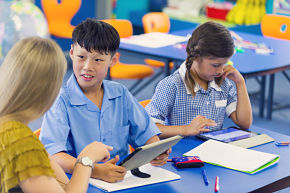Australia is a multicultural country, a melting pot of different languages, beliefs and cultures.
According to the 2016 Census, one-third of the Australian population was born overseas, with nearly one in five arriving since 2012.
Fast forward to 2021, and it’s not surprising that more than one-third of NSW students now come from homes where languages other than English are spoken.

This ever-growing group of students are who Dr Sue Ollerhead, a lecturer in Languages and Literacy Education at Macquarie’s School of Education, is focusing her research on to improve their learning experiences and educational outcomes.
“Much of my research is done in partnership with schools, to help develop rich understandings of the learning experiences of English as an additional language (EAL) students and their teachers’ practices,” says Sue.
“My experiences of teaching in four different countries have shown me that there is often a profound disconnect between learners’ home languages and the language of instruction in the classroom. This disconnect often impacts negatively on their ability to access classroom knowledge, their sociocultural identity development and their educational outcomes.”
In order to mend this ‘disconnect’, Sue recommends teachers embrace student-centred teaching strategies with a focus on two-way dialogue.
“I have witnessed many instances where teachers have viewed multilingual learners through a deficit lens, missing out on valuable opportunities to access and use their existing knowledge and language strengths,” Sue explains.
“I believe that teachers need adequate sociocultural awareness of their students to be able to craft instructional practices based on students’ realities, histories and perspectives to connect their students to classroom content.”
There are two important theoretical constructs that frame Sue’s research, the first is pedagogical translanguaging, whereby teachers systematically plan for multilingual students to use all of their languages when participating in aspects of classroom learning.
“This is a planned, scaffolded strategy designed into a lesson or unit of work and determined by students’ language and learning needs,” says Sue.
The second theoretical construct is pedagogical language knowledge, which refers to the core knowledge all teachers need to have about the nature of language and its crucial role in cognition, as well as practices that can best support a student’s language development.
“Pedagogical language knowledge includes an understanding of second language acquisition, multilingualism and sociocultural aspects of language. It also comprises knowledge of teaching skills such as scaffolding learners’ engagement in language-rich activities, capitalising on learners’ cultural and linguistic diversity and using talk as a tool for learning.”
There are a number of resources available online for educators wanting more information on EAL teaching, such as this one from the NSW Department of Education and the Centre for Educational Statistics in Education: Schools: Language diversity in NSW 2020.